EXO NitraLED Put to the Test in Ohio Watershed Monitoring
When YSI wanted to put its new, portable UV Nitrate Sensor—the EXO NitraLED—to the test, Fred Milan at Del-Co Water in Delaware, Ohio, was an ideal partner. For one thing, Milan covers a lot of ground for Del-Co in his compliance testing and watershed monitoring activities. With a footprint in seven counties, intakes on two major rivers and four reservoirs, a groundwater well field and 30 above-ground tanks, Del-Co is Ohio’s largest private water utility.
As water quality fluctuates and water demand in the district skyrockets from 3 million gallons per day (mgd) in the winter to 18 mgd in the summer, Del-Co managers constantly decide which intakes to activate. Milan jumped at the chance to compare the EXO NitraLED at Del-Co’s Lawrence R. Schreiber pump station side-by-side with the district’s existing, lamp-based nitrate testing spectrometers. He is also excited to take the NitraLED into the field for in-situ nitrate measurements in the water column this summer.
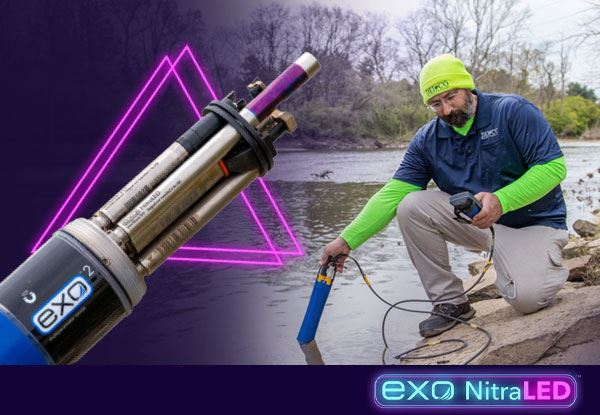
Fred Milan of Del-Co Water uses the NitraLED UV Nitrate Sensor on an EXO Sonde to monitor water quality in drinking water reservoirs.
“We’re at the point where we do not have the ability to remove nitrates, but with 1.6 billion gallons in our reservoirs, we do have the opportunity to pick and choose our source water,” Milan says.
“It’s the same for the rivers. We can say, ‘hey, nitrates are high over on the Scioto River, but we’ve got water in the Olentangy. Let’s go ahead and switch sources for a while, kind of move it back and forth. That way, we can keep our numbers down in the reservoir.’ We have some built-in flexibility with the two rivers, so we try to maximize its potential.”
Portable nitrate testing can also shed light on the movement of water through Del-Co’s system, he adds.
“Nitrates are actually a very good indicator of flow or detention rate,” Milan explains. “With that nitrate data, you can really plot a good trend to show you, ‘OK, if we have 1 milligram per liter of nitrates in Reservoir 5 and we’re bringing in 2 milligrams per liter from the river, as the nitrate level in 5 goes up I can track it in the following reservoirs and we can get an idea of how long it takes those nitrates to pass through the reservoir system before it gets to the plant.’”
Can’t Let Good Water Go By
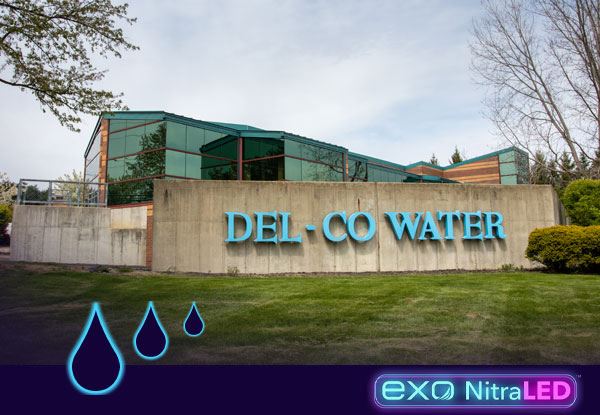
Del-Co Water services seven counties in central Ohio, providing water to over 150,000 people.
Peak summer water demand of 18 million gallons per day (mgd) in Del-Co Water’s service area has strained the Ohio district’s reservoir system at times, shortening detention time in the ponds to about 30 days and taking reservoir levels down near zero by the end of droughty seasons.
Fred Milan, who manages Del-Co’s compliance testing and watershed monitoring, says that leaves little slack for letting good river water flow past reservoirs that need filling during the spring.
“When I first started, they would basically turn the river pumps off in late April just because you knew you were going to get runoff from the farmers’ fields.
’Oh, we’ll just get by on the reservoirs,’ because, in the past, we were able to do that,” he recalls.
“But with increased population comes increased demand, and we don’t have the luxury of saying, ‘we’re going to let everything go by.’ Now we have to be able to know what we have and say, ‘is this acceptable to our standards? OK, great, let’s go ahead and pump,’ or, ‘OK, this is poor quality water. We don’t want to bring this into our reservoirs. Let’s leave the pumps off.’ Instead of letting good water go by, we could be pumping it into our reservoirs.”
Revolutionary LED Technology
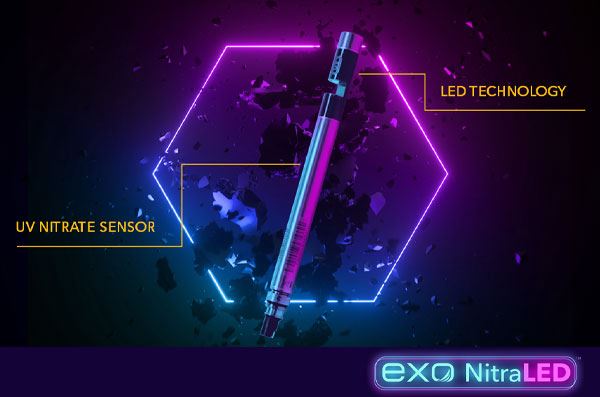
The EXO NitraLED sensor is a revolution in nitrate measurement technology wrapped in a rugged housing the size of a large cigar...and priced at a fraction of the cost of other nitrate monitors.
Unlike bulky, broad-spectrum xenon or deuterium lamp systems, the NitraLED uses an LED light source that delivers UV energy at 235 and 275 nm, two wavelengths in a narrow band that zeros in on frequencies that can signal the presence of nitrate and some types of natural organic matter. The LED operates on just 1/100 the amount of energy required for lamp systems. That remarkable energy efficiency allows the NitraLED to fit the YSI EXO sonde platform, which gathers measurements for weeks at a time on D-cell batteries.
Chris Palassis, Director of Sensor Development for Xylem’s Advanced Technology Incubator (ATI) team, who initially led the NitraLED development program, points out that YSI and its parent company, Xylem, have long been leaders in LED technology in water quality analysis.
“We use LEDs for chlorophyll detection. We use them for turbidity detection and dissolved oxygen,” Palassis points out. “Typically, we use LEDs in a fluorescence application or a scattering application.
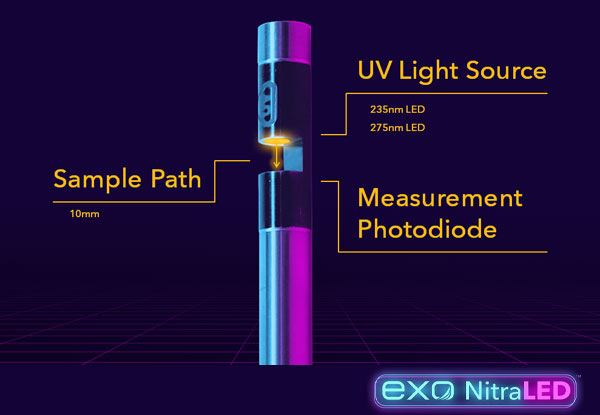
For the NitraLED, we worked with one of our suppliers to develop LEDs that can emit wavelengths in the UV spectrum that until now have been out of reach and create a manufacturing process that can produce them at a commercial scale. We have really pushed the technology to new limits.”
Like the LED, the optical sensor in the NitraLED is tuned to a narrow band of UV wavelengths, enhancing its efficiency compared to conventional, broad-spectrum ion-selective electrodes. As a result, the NitraLED sensor does not require daily calibration, making it ideal for long, unattended deployments.
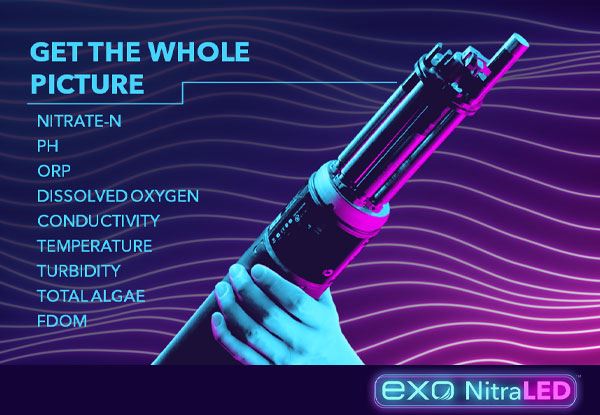
The EXO platform pairs the NitraLED with onboard turbidity and temperature sensors, sharing data on the system’s internal processor to correct for environmental factors that can impact absorbance. (Learn more, EXO NitraLED | Top 4 Tips for Site Specific Corrections). Additional smart sensor ports on EXO Sondes allow users to select among dozens of water quality parameters, including pH, DO, conductivity, TSS or TDS, ORP/Redox, fDOM (fluorescent dissolved organic matter), cyanobacteria, and more.
Easy-to-use Kor Software manages each sonde’s data, which is stored in onboard memory and can be transmitted via cellular or modem signal.
Milan is also a fan of the automatic central wiper on the EXO2 and EXO3 sondes, which regularly cleans all the sensors, including the NitraLED—vital where fouling is a challenge.
“I mean, the whole point of getting a real-time data collection system up and going is you need to be able to trust the results,” he notes. “And the EXO3 with the wiper motor is a must-have over at the side of the river. It keeps the sensors functional.”
Side-By-Side
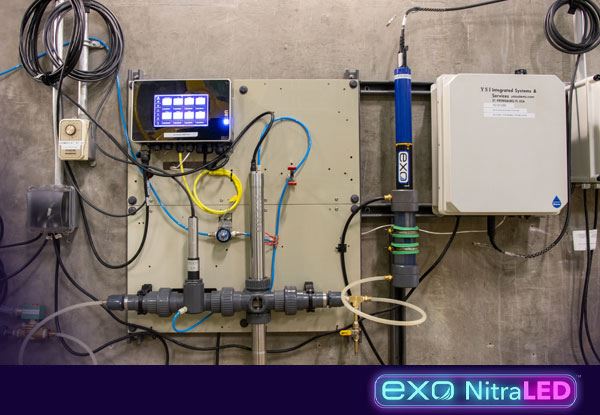
Fred Milan of Del-Co Water tested the new YSI EXO NitraLED nitrate smart sensor in one of the utility’s pumping stations side-by-side against more expensive, lamp-based sensors.
Milan conducted 24-hour-per day, continuous nitrate monitoring with the NitraLED on a YSI EXO3 sonde in a pump station on the Scioto River, right beside an s::can Spectralyzer. He also compared the NitraLED readings with results from the district’s Hach DR 5000 and lab samples.
“It was almost identical,” he says. “I think we’re talking maybe a 0.2 or 0.3 mg/L difference max. When the readings went up, they went up on both devices, and when they went down, they went down on both devices.”
Zack Henderson, Environmental Monitoring Product Manager at YSI, says Milan’s meticulous approach to measurement was one of the reasons he was so excited to work with Milan in the beta-testing phase of the system’s development.
“Fred has been in quality control. He’s been a plant operator, he’s building Del-Co’s watershed monitoring program—he really sees the wide variety of uses of a nitrate sensor that can be used in the plant and in the field and watches carefully for how it performs,” Henderson notes.
“He knows the EXO platform so well, and he’s been so helpful in using the NitraLED in different situations and providing great feedback. With Fred’s help, we know the NitraLED has been put through its paces.”
Rugged Instruments
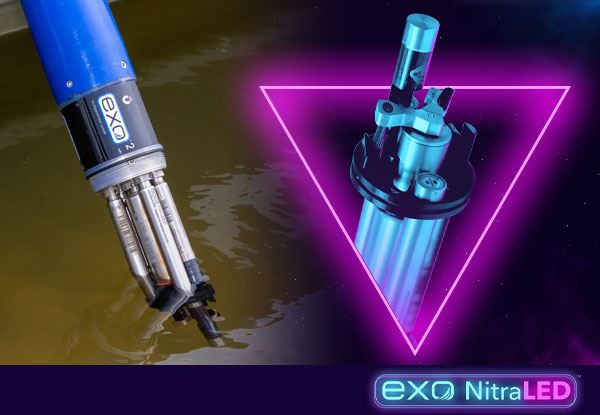
At Del-Co Water, water technician Fred Milan is excited to have a nitrate sensor he can take into the field—especially because he trusts the YSI EXO Sonde platform.
“YSI products are the best—they’re tough, they’re rugged, they’re dependable,” he says. “The EXO2 we use as a portable sonde, it gets thrown in boats, it gets hauled around in the back of pickup trucks, it’s in the lakes and reservoirs and tributaries. It’s gone everywhere and done everything I’ve asked of it.
“We’ve had that EXO2 for five years now, and I just sent it in for annual maintenance and they didn’t have to fix anything on it,” Milan notes. (Learn more, Top Maintenance Tips for EXO Sondes | Protect Your Investment).
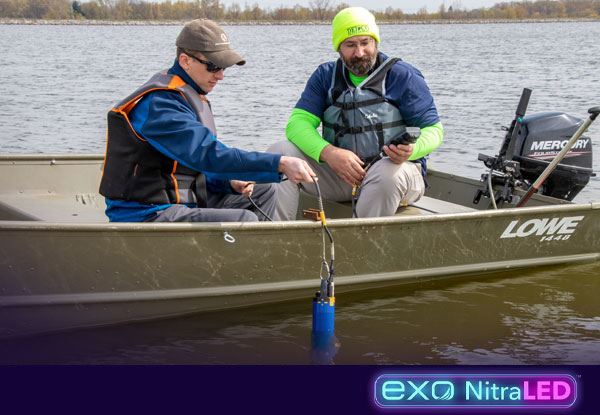
The YSI EXO NitraLED sensor allows Fred Milan (in yellow hat) to measure nitrogen instantly in the field on a multiparameter EXO sonde.
He says service from the YSI team is as reliable as the equipment.
“I love working with YSI,” says Milan. “They’ve got the best reps and technical people. They’re out there with mud on their boots, getting rained on like the rest of us. They know their products—all you have to do is ask. If they don’t have an answer for me by the end of the day, they’ve moved me onto an expert who will have me an answer by the next day.”
All About the Data
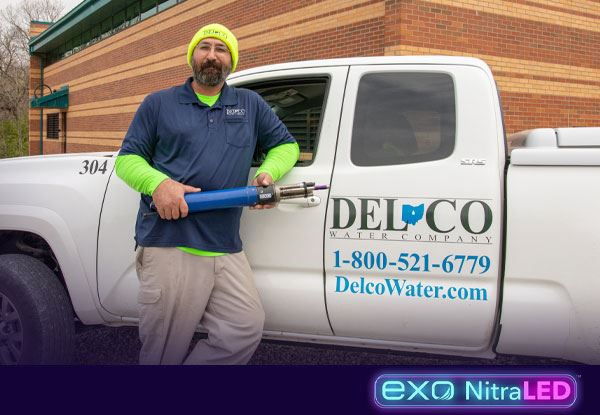
Fred Milan’s meticulous, data-driven approach with Del-Co’s watershed monitoring put the EXO NitraLED UV Nitrate Sensor through its paces.
Milan is a huge proponent of gathering and analyzing data throughout Del-Co’s watershed. He points out that the EXO system is easy to operate, so he has even been comfortable sending an intern out to collect measurements in the field and is confident in the results.
“We have four EXO Sondes, including an EXO2 that we’ll take out in the boat and drop down so we can get readouts at different levels of the water column, usually about every five feet,” he says. “YSI has provided a plethora of sensors—in addition to conductivity, algae, and pH, we’ve added dissolved oxygen, turbidity, and the NitraLED sensor.”
All that data provides a real-time, real-world look at what’s happening in the various water supplies that feed Del-Co’s facilities.
“Generally, April through October, we test the Olentangy at the side of the river and the five tributaries that run into the Olentangy, to try to get an idea of what type of runoff we have,” Milan adds. “We’ve got a pretty good mix of rural and urban so we can get an idea of what type of runoff we’ve got out there and how that’s going to affect our main source supplies.”
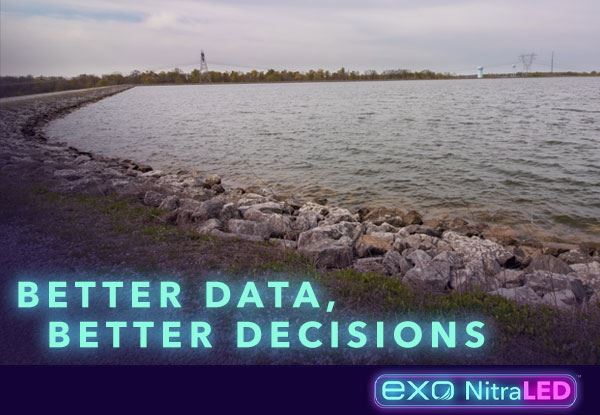
Based on nitrate levels in the two rivers that feed its reservoirs, managers at Del-Co water can switch intakes to achieve water quality targets.
Milan would like to see EXO Sondes in Del-Co’s river sources full-time, steadily feeding water quality data back to a program that allows plant managers, customers and recreation enthusiasts to see the data in real-time. This year, he is adding a NitraLED to the EXO2 he uses in the field, adding nitrate monitoring to its capabilities. Better data means better decisions, he emphasizes.
“I’m all about the data,” says Milan. “I’ve got my experiences and I’ve got my opinions, but I make my decisions off data. I like cold, hard numbers. I like good, reliable equipment that I can use in the field and bring it back to the lab and say, ‘hey, this physically checks. My readings are as good out in the field as they are in the lab.’ And then with that data, we can go ahead and make good decisions about what we need to do so we can make positive changes out in the watershed.”
